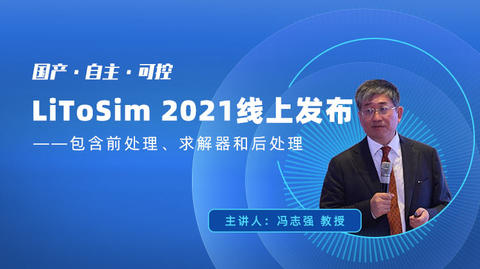LiToForm金属成形CAE软件
本文摘要(由AI生成):
文章主要介绍了LiToForm金属板料成形CAE软件,该软件可用于汽车、航空、航天、舰船等领域,涉及拉伸/冲压、多工步等工艺,以及主应力分布的FLC安全范围、起皱、零件损伤、残余应力计算、弹性回弹的模具补偿、零件附加面优化等方面的应用。LiToForm将推出增量法、逆法和拟逆法三种可选方法,其中拟逆法结合了增量法的高精度和逆法的高效两个优点,为用户提供第三个选择。此外,文章还介绍了工业应用背景、国外商用软件、挤出成形数值仿真、锻压、冲压等方面的内容。
LiToForm金属成形CAE软件基于励颐拓仿真软件开发共性平台LiToDesk开发,在通用求解器LiToSim的基础上,考虑了金属成形特有算法,形成了针对金属成形领域的定制化CAE软件。 LiToForm将包含板料成形和体积成形两大模块。 
包含但是不限于:汽车,航空,航天,舰船等。通常的工艺有拉伸/冲压,多工步等。涉及到的应用有:主应力分布的FLC安全范围,起皱,零件损伤,残余应力计算,弹性回弹的模具补偿,零件附加面优化等方面。
 多工步成形
多工步成形
损伤模拟

LiToForm将在LiToSim通用软件的基础上,开发出一款适用于金属板料成形的专用CAE软件。LiToForm将与LiToSim的前后处理器无缝衔接,继承LiToSim友好和高效的用户界面。商用金属板料成形CAE软件一般基于两种算法:有限元增量法和逆法。增量法从初始板料形状通过大量的小步正向计算到最终形状。其模拟精度相对较高,在模具正式生产前有相对可靠的应力应变等数值模拟参考。基于有限元增量法的国外商用板料成形的CAE软件主要有AUTOFORM,DYNAFORM,STAMPACK等。逆法从最终形状通过一步反算初始板料形状。由于缺少中间步骤,其应力模拟精度比增量法低,应变精度没有下降太多。它优点是快速,能应用于快速优化,逆法对快速模具设计有高效的指导作用。缺点是缺少中间步骤,不能模拟与变形历史相关的损伤。国外基于逆法的商用软件主要有AUTOFORM/Onestep等。LiToForm将推出增量法,逆法和拟逆法三种可选方法。拟逆法结合了增量法的高精度和逆法的高效两个优点,为用户提供第三个选择。
体积成形零件应用非常广泛,包含但是不限于:紧固件、机械、仪表、电器、轻工、宇航、船舶、军工等工业。主要有Deform,Forge III,QForm等,这些软件都是基于增量法。
LiToForm将推出增量法和拟逆法两种可选方法,使精确性和快速性得到兼顾。快速性的选择更利于软件应用于优化,使高效模具设计成为可能。比如中间预成形坯形状优化。
金属成形是一个强非线性问题,同时涉及到材料非线性、几何非线性和接触状态非线性。励颐拓团队在各个方面都做了长期的技术积累,结合通用CAE软件LiToSim开发所累积的经验,着手打造金属成形专用仿真软件,与制造业用户建立长期合作关系。
励颐拓团队秉承独立自主路线,致力推进国产CAE软件发展,打造国产自主可控的CAE软件。
1.Cheng YJ, Li Y, Tao L, Joli P, Feng ZQ, An adaptive smoothed particle hydrodynamics for metal cutting simulation, Acta Mechanica Sinica, 38: 422126, 2022 2.Hu LB, Cong Y, Joli P, Feng ZQ, A bi-potential contact formulation for recoverable adhesion between soft bodies based on the RCC interface model, Computer Methods in Applied Mechanics and Engineering, 390, 114478, 2022 3.Thomas AE, Abbès B, Li YM, Abbès F, Duval JL, Thermo-viscoplastic numerical modeling of metal forging process by Pseudo Inverse Approach, Mechanics & Industry, 21(2), 202, 2020 4.Peng L, Feng ZQ, Joli P, Liu JH, Zhou YJ, Automatic contact detection between rope fibers, Computers & Structures, 218:82-93, 2019 5.Zhou YJ, Feng ZQ, Ning P, Wang CY, Numerical Algorithm and Software Development for Metal Forming, Journal of Southwest Jiaotong University, 54(4): 855-862, 2019 6.Zhou YJ, Feng ZQ, Rojas Quintero JA, Ning P, A computational strategy for the modeling of elasto-plastic materials under impact loadings, Finite Elements in Analysis & Design, 142:42-50, 2018 7.Guo YQ, Li YM, Abbes B, Naceur H, Halouani, A Damage Prediction in Metal Forming process modeling and optimization: Simplified approach, Chapter 24 in Handbook of damage Mechanics Nano to macro scale for materials and structures, Edited by: G Z Voyiadjis, Springer, New York, Volume 2: 765 – 813, 2015 8.Halouani A, Li YM, Abbès B, Guo YQ, Efficient pseudo-inverse approach for damage prediction in cold forging process simulation, International Journal of Damage Mechanics 23 (8), 1168-1188, 2014 9.Debray K, Li YM, Guo YQ, Parametric design and optimization of addendum surfaces for sheet metal forming process, International Journal of Material Forming 6 (3), 315-325, 2013 10.Duong P, Abbès B, Li YM, Makhlouf M, Guo YQ, An analytic homogenisation model for shear-torsion coupling problems of double corrugated core sandwich plates, Journal of Composite Materials 47 (11), 1327-1341, 2013 11.Halouani A, Li YM, Abbes B, Guo YQ, Optimization of cold forging perform tools using Pseudo Inverse Approach, Transactions of Nonferrous Metals Society of China (English Edition) 22, 207-213, 2012 12.Halouani A, Li YM, Abbès B, Guo YQ, Simulation of axi-symmetrical cold forging process by efficient pseudo inverse approach and direct algorithm of plasticity, Finite Elements in Analysis and Design 61, 85-96, 2012 13.Halouani A, Li YM, Abbès B, Guo YQ, Fast Pseudo Inverse Approach and direct plasticity algorithm for metal forming modelling, Suxing Gongcheng Xuebao/Journal of Plasticity Engineering 18 (6), 1-14, 2011 14.Feng ZQ, Renaud C, Cros JM, Zhang HW, Guan ZQ, A finite element finite-strain formulation for modeling colliding blocks of Gent materials, International Journal of Solids and Structures, 47, 2215-2222, 2010 15.Halouani A, Li YM, Abbès B, Guo YQ, An Efficient Axi-symmetric Element Based on Inverse Approach for Cold Forging Modeling, Engineering Letters, Vol 18(4), 376-383, 2010 16.Peyraut F, Feng ZQ, He QC, Labed N, Robust numerical analysis of homogeneous and non-homogeneous deformations, Applied Numerical Mathematics, 59, 1499-1514, 2009 17.Li YM, Abbès B, Guo YQ, Two Efficient Algorithms of Plastic Integration for sheet Forming Modelling, Journal of Manufacturing Science and Engineering, Transactions of the ASME 129 (4), 698-704, 2007 18.Feng ZQ, Zei M, Joli P, An elasto-plastic contact model applied to nanoindentation, Computational Materials Science, 38, 807-813, 2007 19.Feng ZQ, Hjiaj M, De Saxcé G, Mróz Z, Influence of frictional anisotropy on contacting surfaces during loading/unloading cycles, International Journal of Non-Linear Mechanics, 41, 936-948, 2006 20.Feng ZQ, Magnain B, Cros JM, Solution of large deformation impact problems with friction between Blatz-Ko hyperelastic bodies, International Journal of Engineering Science, 44, 113-126, 2006 21.Feng ZQ, Hjiaj M, De Saxcé G, Mróz Z, Effect of frictional anisotropy on the quasistatic motion of a deformable solid sliding on a planar surface, Computational Mechanics, 37, 349–361, 2006 22.Titeux I, Li YM, Debray K, Guo YQ, Un algorithme efficace d’intégration plastique pour un matériau obéissant au critère anisotrope de Hill, Comptes Rendus - Mécanique 332 (11), 901-906, 2004 23.Guo YQ, Li YM, Bogard F, Debray K, An efficient pseudo-inverse approach for damage modeling in the sheet forming process, Journal of Materials Processing Technology 151 (1-3 SPEC ISS), 88-97, 2004 24.Cherouat A, Guo YQ, Saanouni K, LI YM, Debray K, Loppin G, Incremental versus inverse numerical approaches for ductile damage prediction in sheet metal forming, International Journal of FormingProcesses, Vol 7, N° 1-2, 99-122, 2004 25.Guo YQ, Li YM, Loppin G, Debray K, Saanouni K, Cherouat A, Two methodologies for the simulation of ductile damage in sheet metal forming processes, Suxing Gongcheng Xuebao/Journal of Plasticity Engineering 9 (4), 47-55, 2002 26.Feng ZQ, De Saxcé G, Rigid-plastic implicit integration scheme for analysis of metal forming, European Journal of Mechanics, A/Solids, 15, 51-66, 1996 27.Feng ZQ, 2D or 3D frictional contact algorithms and applications in a large deformation context, Communications in Numerical Methods in Engineering, 11, 409-416,1995
重庆励颐拓软件有限公司,于2018年7月6日成立,总部位于两江新区中瑞(重庆两江)产业园,在法国巴黎、上海、青岛设有研发中心,同时正在筹备设立成都研发中心。
公司由首席科学家冯志强教授领衔,拥有两院院士及国内外顶级专家组成的顾问团队,并与国内外多个科研团队建立密切合作;公司研发人员占比超过90%,且均为硕士及以上学历。
公司基于冯志强教授团队在理论、模型、算法、软件架构等方面三十余年的技术积累,致力于开发完全自主可控、具有国际先进水平的高端通用CAE软件LiToSim, 并协助不同领域用户开发服务于其核心产品的专用仿真软件,为研究成果积累、行业知识沉淀、CAE人才培养及产品自主创新提供良好的生态环境,为共同打造国产自主可控CAE软件贡献力量。







 多工步成形
多工步成形

































